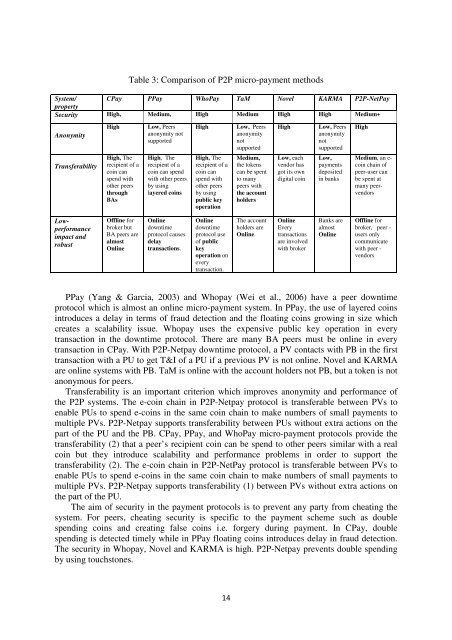View - Faculty of Information and Communication Technologies
View - Faculty of Information and Communication Technologies
View - Faculty of Information and Communication Technologies
You also want an ePaper? Increase the reach of your titles
YUMPU automatically turns print PDFs into web optimized ePapers that Google loves.
Table 3: Comparison <strong>of</strong> P2P micro-payment methods<br />
System/ CPay PPay WhoPay TaM Novel KARMA P2P-NetPay<br />
property<br />
Security High, Medium, High Medium High High Medium+<br />
Anonymity<br />
Transferability<br />
High<br />
High, The<br />
recipient <strong>of</strong> a<br />
coin can<br />
spend with<br />
other peers<br />
through<br />
BAs<br />
Low, Peers<br />
anonymity not<br />
supported<br />
High, The<br />
recipient <strong>of</strong> a<br />
coin can spend<br />
with other peers<br />
by using<br />
layered coins<br />
High<br />
High, The<br />
recipient <strong>of</strong> a<br />
coin can<br />
spend with<br />
other peers<br />
by using<br />
public key<br />
operation<br />
Low, Peers<br />
anonymity<br />
not<br />
supported<br />
Medium,<br />
the tokens<br />
can be spent<br />
to many<br />
peers with<br />
the account<br />
holders<br />
High<br />
Low, each<br />
vendor has<br />
got its own<br />
digital coin<br />
Low, Peers<br />
anonymity<br />
not<br />
supported<br />
Low,<br />
payments<br />
deposited<br />
in banks<br />
High<br />
Medium, an e-<br />
coin chain <strong>of</strong><br />
peer-user can<br />
be spent at<br />
many peervendors<br />
Lowperformance<br />
impact <strong>and</strong><br />
robust<br />
Offline for<br />
broker but<br />
BA peers are<br />
almost<br />
Online<br />
Online<br />
downtime<br />
protocol causes<br />
delay<br />
transactions.<br />
Online<br />
downtime<br />
protocol use<br />
<strong>of</strong> public<br />
key<br />
operation on<br />
every<br />
transaction.<br />
The account<br />
holders are<br />
Online.<br />
Online<br />
Every<br />
transactions<br />
are involved<br />
with broker<br />
Banks are<br />
almost<br />
Online<br />
Offline for<br />
broker, peer -<br />
users only<br />
communicate<br />
with peer -<br />
vendors<br />
PPay (Yang & Garcia, 2003) <strong>and</strong> Whopay (Wei et al., 2006) have a peer downtime<br />
protocol which is almost an online micro-payment system. In PPay, the use <strong>of</strong> layered coins<br />
introduces a delay in terms <strong>of</strong> fraud detection <strong>and</strong> the floating coins growing in size which<br />
creates a scalability issue. Whopay uses the expensive public key operation in every<br />
transaction in the downtime protocol. There are many BA peers must be online in every<br />
transaction in CPay. With P2P-Netpay downtime protocol, a PV contacts with PB in the first<br />
transaction with a PU to get T&I <strong>of</strong> a PU if a previous PV is not online. Novel <strong>and</strong> KARMA<br />
are online systems with PB. TaM is online with the account holders not PB, but a token is not<br />
anonymous for peers.<br />
Transferability is an important criterion which improves anonymity <strong>and</strong> performance <strong>of</strong><br />
the P2P systems. The e-coin chain in P2P-Netpay protocol is transferable between PVs to<br />
enable PUs to spend e-coins in the same coin chain to make numbers <strong>of</strong> small payments to<br />
multiple PVs. P2P-Netpay supports transferability between PUs without extra actions on the<br />
part <strong>of</strong> the PU <strong>and</strong> the PB. CPay, PPay, <strong>and</strong> WhoPay micro-payment protocols provide the<br />
transferability (2) that a peer’s recipient coin can be spend to other peers similar with a real<br />
coin but they introduce scalability <strong>and</strong> performance problems in order to support the<br />
transferability (2). The e-coin chain in P2P-NetPay protocol is transferable between PVs to<br />
enable PUs to spend e-coins in the same coin chain to make numbers <strong>of</strong> small payments to<br />
multiple PVs. P2P-Netpay supports transferability (1) between PVs without extra actions on<br />
the part <strong>of</strong> the PU.<br />
The aim <strong>of</strong> security in the payment protocols is to prevent any party from cheating the<br />
system. For peers, cheating security is specific to the payment scheme such as double<br />
spending coins <strong>and</strong> creating false coins i.e. forgery during payment. In CPay, double<br />
spending is detected timely while in PPay floating coins introduces delay in fraud detection.<br />
The security in Whopay, Novel <strong>and</strong> KARMA is high. P2P-Netpay prevents double spending<br />
by using touchstones.<br />
14
















